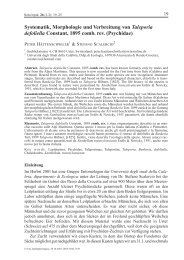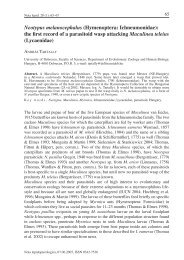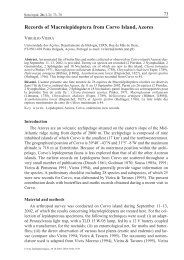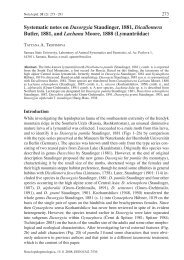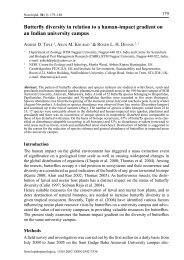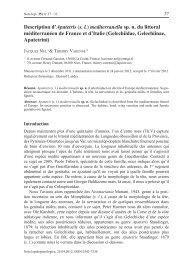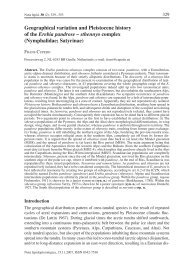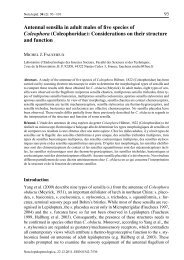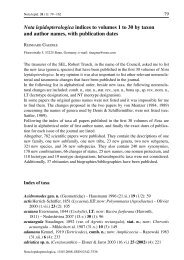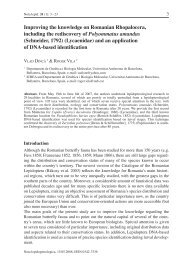Checklist of Butterflies (Papilionoidea) of the Mongolian Altai ...
Checklist of Butterflies (Papilionoidea) of the Mongolian Altai ...
Checklist of Butterflies (Papilionoidea) of the Mongolian Altai ...
You also want an ePaper? Increase the reach of your titles
YUMPU automatically turns print PDFs into web optimized ePapers that Google loves.
82 YAKOVLEV: <strong>Butterflies</strong> <strong>of</strong> <strong>the</strong> <strong>Mongolian</strong> <strong>Altai</strong><br />
Khasgt-Khirkhan Mountains E. chastilovi is a bona fide species and its status as a species<br />
is based on <strong>the</strong> following characters: clear external distinctions (detailed in <strong>the</strong> original<br />
description) and some distinctions in genitalia morphology (valve is strongly curved,<br />
with a specific process distally forming an almost flat area with small denticles on it,<br />
and a larger denticle at <strong>the</strong> base <strong>of</strong> <strong>the</strong> process; <strong>the</strong> antevaginal plate is U-shaped, with<br />
ra<strong>the</strong>r massive lateral processes, as opposed to <strong>the</strong> much smaller structures in altajana<br />
Staudinger, 1901). The new subspecies from <strong>the</strong> nor<strong>the</strong>rn part <strong>of</strong> <strong>the</strong> distribution area<br />
(Khovd aimak, Ikh-Nuruu Mountains) is described and differentiated based on wing<br />
pattern elements, smaller size, and slight differences in female genitalia morphology.<br />
Erebia chastilovi nomada ssp. n. (Figs 22i – n, 23d, 24i – o, 25)<br />
Material. Holotype P, W Mongolia, Khovd aimak, Ikh-Nuruu Mountains (between Bodonchin-Gol<br />
and Uenchin-Gol valleys), Ikh-Daba pass, 2900m, 5.vii.2007, leg. R. Yakovlev (ZISP). – Paratypes: 11<br />
PP, 4 OO, same data (ZISP, RYB).<br />
Diagnosis. The new subspecies differs from <strong>the</strong> nominate in its smaller size (<strong>the</strong> length<br />
<strong>of</strong> <strong>the</strong> forewing is 15 – 16.5 mm, and 16 – 18.5 mm in <strong>the</strong> nominate subspecies). The<br />
wing upperside in males has a better defined ochreous pattern, forming a wide area in<br />
<strong>the</strong> forewing and consisting <strong>of</strong> small submarginal dashes in <strong>the</strong> hindwing. The hindwing<br />
underside is more brightly coloured, with a very well-defined marmorate pattern. The<br />
male genitalia have no obvious distinctions. The female genitalia bear signa, strongly<br />
converging distally on <strong>the</strong> corpus bursae.<br />
Habitat. Very dry alpian tundra-steppe.<br />
Etymology. The subspecies name comes from <strong>the</strong> word “nomad”.<br />
Erebia pandrose (Borkhausen, 1788)<br />
Tsagan-Kol Lake, rare and local.<br />
Hyponephele lycaon (Rottemburg, 1775) (Figs 26 – 27)<br />
This species is very variable in Central Asia. Ssp. catalampra (Staudinger, 1895), described<br />
from <strong>the</strong> Central Khangai Mountains, has been traditionally considered present<br />
in Mongolia and is listed in <strong>the</strong> recent book with all western and central <strong>Mongolian</strong><br />
populations (Tschikolovets et al. 2009). However, populations from different areas<br />
<strong>of</strong> <strong>the</strong> <strong>Mongolian</strong> <strong>Altai</strong> are very variable externally and represent very well-delineated<br />
taxa, whose rank needs refinement. In order to refine <strong>the</strong> real rank considerable<br />
additional material and molecular-genetic studies are required. Here taxa from <strong>the</strong><br />
<strong>Mongolian</strong> <strong>Altai</strong> are considered as subspecies. Probably such a pr<strong>of</strong>usion <strong>of</strong> phenotypes<br />
is caused by <strong>the</strong> complete isolation <strong>of</strong> river valleys in <strong>the</strong> south <strong>of</strong> <strong>the</strong> <strong>Mongolian</strong><br />
<strong>Altai</strong>, thus making <strong>the</strong> genetic exchange between populations <strong>of</strong> Hyponephele lycaon<br />
impossible. The extreme west <strong>of</strong> <strong>the</strong> sou<strong>the</strong>rn macroslope <strong>of</strong> <strong>the</strong> <strong>Mongolian</strong> <strong>Altai</strong> is<br />
inhabited with ssp. smirnovi Yakovlev, 2004 stat. n. (LT: Arshantyn-Nuruu Mountains)<br />
(Figs 26a, b). Similar topotypical butterflies were collected in <strong>the</strong> valley <strong>of</strong> Ulyastain-<br />
Gol River. Eastwards in <strong>the</strong> Mogoin-Gol river valley and <strong>the</strong> Hara-Adzragyn-Nuru<br />
Mountains a small series <strong>of</strong> specimens was collected, different from all <strong>the</strong> known<br />
forms <strong>of</strong> Hyponephele lycaon, and it is described here as a new subspecies.



